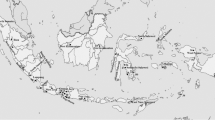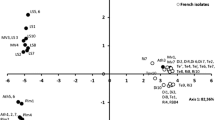Abstract
Phytophthora cinnamomi isolates from South Africa and Australia were compared to assess genetic differentiation between the two populations. These two populations were analysed for levels of phenotypic diversity using random amplified polymorphic DNAs (RAPDs) and gene and genotypic diversity using restriction fragment length polymorphisms (RFLPs). Sixteen RAPD markers from four decanucleotide Operon primers and 34 RFLP alleles from 15 putative loci were used. A few isolates from Papua New Guinea known to posses alleles different from Australian isolates were also included for comparative purposes. South African and Australian P. cinnamomi populations were almost identical with an extremely low level of genetic distance between them (Dm=0.003). Common features for the two populations include shared alleles, low levels of phenotypic/genotypic diversity, high clonality, and low observed and expected levels of heterozygosity. Furthermore, relatively high levels of genetic differentiation between mating type populations (Dm South Africa=0.020 and Dm Australia=0.025 respectively), negative fixation indices, and significant deviations from Hardy–Weinberg equilibrium, all provided evidence for the lack of frequent sexual reproduction in both populations. The data strongly suggest that both the South African and Australian P. cinnamomi populations are introduced.
Similar content being viewed by others
References
Arentz F and Simpson JA (1986) Distribution of Phytophthora cinnamomi in Papua New Guinea and notes on its origin. Transactions of the British Mycological Society 87: 289-295
Botstein D, White RL, Skolnick M and Davis RW (1980) Construction of a genetic linkage map in man using restriction fragment length polymorphisms. American Journal of Human Genetics 32: 314-331
Brown AHD (1979) Enzyme polymorphism in plant populations. Theoretical Population Biology 15: 1-42
Chang TT, Yang WW and Wang WY (1996) Use of random amplified polymorphic DNA markers for the detection of genetic variation in Phytophthora cinnamomi in Taiwan. Botanical Bulletin of Academia Sinica 37: 165-171
Chen RS, Boeger JM and McDonald BA (1994) Genetic stability in a population of a plant pathogenic fungus over time. Molecular Ecology 3: 209-218
Darvas JM, Toerien JC and Milne DL (1984) Control of avocado root rot by trunk injection with phosetyl-Al. Plant Disease 68: 691-693
Drenth A, Goodwin SB, Fry WE and Davidse LC (1993) Genotypic diversity of Phytophthora infestans in The Netherlands revealed by DNA polymorphisms. Phytopathology 83: 1087-1092
Drenth A, Tas ICQ and Govers F (1994) DNA fingerprinting uncovers a new sexually reproducing population of Phytophthora infestans in the Netherlands. European Journal of Plant Pathology 100: 97-107
Drenth A, Whisson SC, Maclean DJ, Irwin JAG, Obst NR and Ryley MJ (1996) The evolution of races of Phytophthora sojae in Australia. Phytopathology 86: 163-169
Förster H, Tyler BM and Coffey MD (1994) Phytophthora sojae races have arisen by clonal evolution and by rare outcrosses. Molecular Plant-Microbe Interaction 7: 780-791
Fry WE, Goodwin SB, Dyer AT, Matuszak JM, Drenth A, Tooley PW, Sujkowski LS, Koh YJ, Cohen BA, Spielman LJ, Deahl KL, Inglis DA and Sandlan KP (1993) Historical and recent migrations of Phytophthora infestans: Chronology, pathways, and implications. Plant Disease 77: 653-661
Fry WE, Goodwin SB, Matuszak JM, Spielman LJ, Milgroom MG and Drenth A (1992) Population genetics and intercontinental migrations of Phytophthora infestans. Annual Review of Phytopathology 30: 107-129
Goodwin SB (1997) The population genetics of Phytophthora. Phytopathology 87: 462-473
Goodwin SB, Barak AC, Deahl KL and Fry WE (1994) Migration from northern Mexico as the probable cause of recent genetic changes in populations of P. infestans in the United States and Canada. Phytopathology 84: 553-558
Goodwin SB, Spielman LJ, Matuszak JM, Bergeron SN and Fry WE (1992) Clonal diversity and genetic differentiation of Phytophthora infestans populations in northern and central Mexico. Phytopathology 82: 955-961
Goodwin SB, Sujkowski LS, Dyer AT, Fry BA and Fry WE (1995) Direct detection of gene flow and probable sexual reproduction of Phytophthora infestans in northern North America. Phytopathology 85: 473-479
Kassaby FY, Fagg PC and Marks GC (1977) Survival in, and colonization of mountain forest by Phytophthora cinnamomi Rands in eastern Victoria. Australian Forestry Research 7: 173-183
Leung H, Nelson RJ and Leach JE (1993) Population structure of plant pathogenic fungi and bacteria. Advances in Plant Pathology 10: 157-205
Linde C, Drenth A, Kemp GHJ, Wingfield MJ and von Broembsen SL (1997) Population structure of Phytophthora cinnamomi in South Africa. Phytopathology 87: 822-827
McDonald BA, Miles J, Nelson LR and Pettyway RE (1994) Genetic variability in nuclear DNA in field populations of Stagonospora nodorum. Phytopathology 84: 250-255
Michelmore RW and Hulbert SH (1987) Molecular markers for genetic analysis of phytopathogenic fungi. Annual Review of Phytopathology 25: 383-404
Milgroom MG and Fry WE (1997) Contributions of population genetics to plant disease epidemiology and management. Advances in Botanical Research 24: 1-30
Nei M (1973) Analysis of gene diversity in subdivided populations. Proceedings of the National Academy of Science USA 70: 3321-3323
Nei M (1978) Estimation of average heterozygosity and genetic distance from a small number of individuals. Genetics 89: 583-590
Old KM, Dudzinski MJ and Bell JC (1988) Isozyme variability in field populations of Phytophthora cinnamomi in Australia. Australian Journal of Botany 36: 355-360
Old KM, Moran GF and Bell JC (1984) Isozyme variability among isolates of Phytophthora cinnamomi from Australia and Papua New Guinea. Canadian Journal of Botany 62: 2016-2022
Pieterse CMJ, van't Klooster J, van den Berg-Velthuis GCM and Govers F (1995) NiaA, the structural nitrate reductase gene of Phytophthora infestans: isolation, characterization and expression analysis in Aspergillus nidulans. Current Genetics 27: 359-366
Pieterse CMJ, Verbakel HM, Hoek Spaans J, Davidse LC and Govers F (1993) Increased expression of the calmodulin gene of the late blight fungus Phytophthora infestans during pathogenesis on potato. Molecular Plant Microbe Interactions 6: 164-171
Podger FD, Doepel RF and Zentmyer GA (1965) Association of Phytophthora cinnamomi with a disease of Eucalyptus marginata forest in Western Australia. Plant Disease Reporter 49: 943-947
Pratt BH and Heather WA (1973) The origin and distribution of Phytophthora cinnamomi Rands in Australian native plant communities and the significance of its association with particular plant species. Australian Journal of Biological Sciences 26: 575-582
Sambrook J, Fritsch EF and Maniatis T (1989) Molecular cloning: A Laboratory Manual, Second edition, Cold Spring Harbor Press, Cold Spring Harbor, NY
Shepherd CJ (1975) Phytophthora cinnamomi — An ancient immigrant to Australia. Search 6: 484-490
Stoddard JA and Taylor JF (1988) Genotypic diversity: Estimation and prediction in samples. Genetics 118: 705-711
Swofford DL and Selander RB (1981) BIOSYS-1: A FORTRAN program for the comprehensive analysis of electrophoretic data in population genetics and systematics. Journal of Heredity 72: 281-283
Tooley PW, Fry WE and Villareal-González MJ (1985) Isozyme characterization of sexual and asexual Phytophthora infestans populations. Journal of Heredity 76: 431-435
Unkles SA, Moon RP, Hawkins AR, Duncan JM and Kinghorn JR (1991) Actin in the oomycetous fungus Phytophthora infestans is the product of several genes. Gene 100: 105-112
Van der Merwe JJH, Joubert DJ and Matthee FN (1972) Phytophthora cinnamomi root rot of grapevines in the Western Cape. Phytophylactica 4: 133-136
Von Broembsen SL (1989) Biogeography of Phytophthora cinnamomi mating types in South Africa. Phytopathology 79: 1185 (abstract)
Von Broembsen SL and Brits GJ (1985) Phytophthora root rot on commercially cultivated proteas in South Africa. Plant Disease 69: 211-213
Wager VA (1942) Phytophthora cinnamomi and wet soil in relation to the dying-back of avocado trees. Hilgardia 14: 519-532
Weste G (1994) Impact of Phytophthora species on native vegetation of Australia and Papua New Guinea. Australasian Plant Pathology 23: 190-209
Wingfield MJ and Knox-Davies PS (1980) Observations on diseases in pine and eucalyptus plantations in South Africa. Phytophylactica 12: 57-60
Williams JGK, Kubelik AR, Livak KJ, Rafalski JA and Tingey SV (1990) DNA polymorphisms amplified by arbitrary primers are useful as genetic markers. Nucleic Acids Research 18: 6531-6535
Zentmyer GA (1961) Chemotaxis of zoospores for root exudates. Science 133: 1595-1596
Zentmyer GA (1980) Phytophthora cinnamomi and the diseases it causes. The American Phytopathological Society, St. Paul, MN
Zentmyer GA (1988) Origin and distribution of four species of Phytophthora. Transactions of the British Mycological Society 91: 367-378
Zentmyer GA and Mircetich SM (1966) Saprophytism and persistence in soil by Phytophthora cinnamomi. Phytopathology 56: 710-712
Author information
Authors and Affiliations
Rights and permissions
About this article
Cite this article
Linde, C., Drenth, A. & Wingfield, M.J. Gene and Genotypic Diversity of Phytophthora cinnamomi in South Africa and Australia Revealed by DNA Polymorphisms. European Journal of Plant Pathology 105, 667–680 (1999). https://doi.org/10.1023/A:1008755532135
Issue Date:
DOI: https://doi.org/10.1023/A:1008755532135




